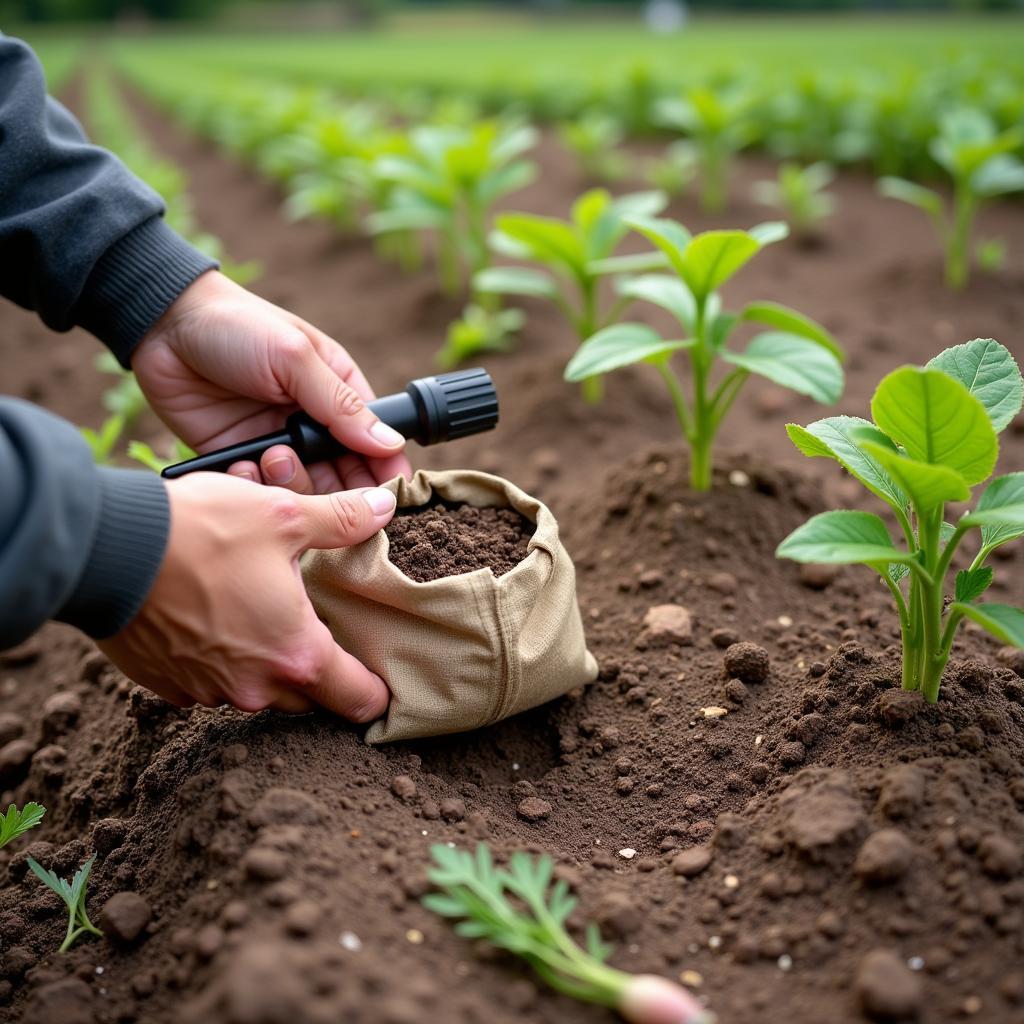Growing a thriving turnip food plot requires more than just scattering seeds. The Best Fertilizer For Turnip Food Plots plays a crucial role in achieving the lush, nutritious forage that attracts and sustains wildlife. In this comprehensive guide, we’ll delve into the specifics of fertilizing your turnip food plot for optimal results.
Understanding Turnip Fertilizer Needs
Turnips, like all brassicas, are heavy feeders, demanding a rich supply of nutrients for robust growth. They require a fertilizer with a balanced ratio of nitrogen (N), phosphorus (P), and potassium (K), often expressed as an NPK ratio. A soil test is the most accurate way to determine the existing nutrient levels and identify any deficiencies. This will guide you in choosing the best fertilizer for turnip food plots in your specific location. Generally, a fertilizer with an NPK ratio of 10-10-10 or similar is a good starting point.
 Soil Testing for Turnip Food Plots
Soil Testing for Turnip Food Plots
Why is Nitrogen Important?
Nitrogen promotes leafy growth, essential for establishing a strong turnip canopy. Adequate nitrogen levels contribute to larger, more palatable leaves, which are highly attractive to deer and other wildlife.
The Role of Phosphorus
Phosphorus is crucial for root development and overall plant health. Strong roots allow turnips to access water and nutrients more effectively, leading to more vigorous growth, especially in the early stages.
Potassium for Turnip Health
Potassium contributes to disease resistance and overall plant vigor. It also helps regulate water uptake and improves the plant’s ability to withstand environmental stresses like drought or temperature fluctuations.
If you’re interested in exploring food plot options for shaded areas, check out our guide on the best food plot for shaded areas.
Choosing the Right Fertilizer
Several types of fertilizers are suitable for turnip food plots. Granular fertilizers are a popular choice due to their ease of application and affordability. Liquid fertilizers offer quicker nutrient uptake but can be more expensive. Organic options, such as compost or manure, provide a slow-release of nutrients and improve soil health over time.
Granular Fertilizers
Granular fertilizers are easy to spread using a hand-held spreader or ATV-mounted spreader. They are available in various NPK ratios, allowing you to tailor your application to the specific needs of your turnip plot.
Liquid Fertilizers
Liquid fertilizers are readily absorbed by plants, providing a quick nutrient boost. They are ideal for addressing immediate deficiencies or for foliar applications.
Organic Fertilizers
Organic fertilizers improve soil structure and promote long-term soil health. While they may not provide the immediate nutrient boost of synthetic fertilizers, they contribute to a more sustainable and environmentally friendly food plot. For more on brassica food plots and attracting deer, you might find our article on brassica food plots deer helpful.
Application Timing and Methods
The timing of fertilizer application is crucial for maximizing turnip growth. Apply a starter fertilizer at planting to encourage rapid establishment. A second application can be made a few weeks later to support continued growth. Avoid fertilizing too late in the season, as this can lead to excessive leafy growth and reduce bulb development. Always follow the manufacturer’s instructions for application rates and methods. Interested in a pre-mixed seed blend? Take a look at our deer food plot seed mix.
Maximizing Your Turnip Food Plot
Choosing the best fertilizer is just one piece of the puzzle. Proper soil preparation, planting techniques, and weed control are equally important for achieving a successful turnip food plot. Consider planting a brassica blend food plot seed for a diverse and nutritious food source. For those preparing for colder months, our guide on the best winter food plots for deer offers valuable insights.
Expert Insight: “A healthy soil is the foundation of a productive food plot. Don’t underestimate the importance of soil testing and addressing any nutrient deficiencies before planting.” – Dr. Sarah Miller, Wildlife Biologist.
Expert Insight: “Turnips are a valuable food source for wildlife, especially during the fall and winter months. Proper fertilization ensures they reach their full potential, providing maximum nutritional benefits.” – John Davis, Experienced Food Plot Manager.
In conclusion, selecting the best fertilizer for turnip food plots involves understanding the nutrient needs of turnips, choosing the right fertilizer type, and applying it at the correct time. By following these guidelines, you can create a flourishing food plot that attracts and nourishes wildlife throughout the season.
FAQ
- What is the best NPK ratio for turnips?
- When should I fertilize my turnip food plot?
- Can I use organic fertilizer for turnips?
- How much fertilizer should I apply?
- How can I test my soil?
- What other factors contribute to a successful turnip food plot?
- Where can I buy turnip seeds and fertilizer?
For assistance, please contact us at Phone Number: 02437655121, Email: [email protected], or visit us at 3PGH+8R9, ĐT70A, thôn Trung, Bắc Từ Liêm, Hà Nội, Việt Nam. We have a 24/7 customer service team.